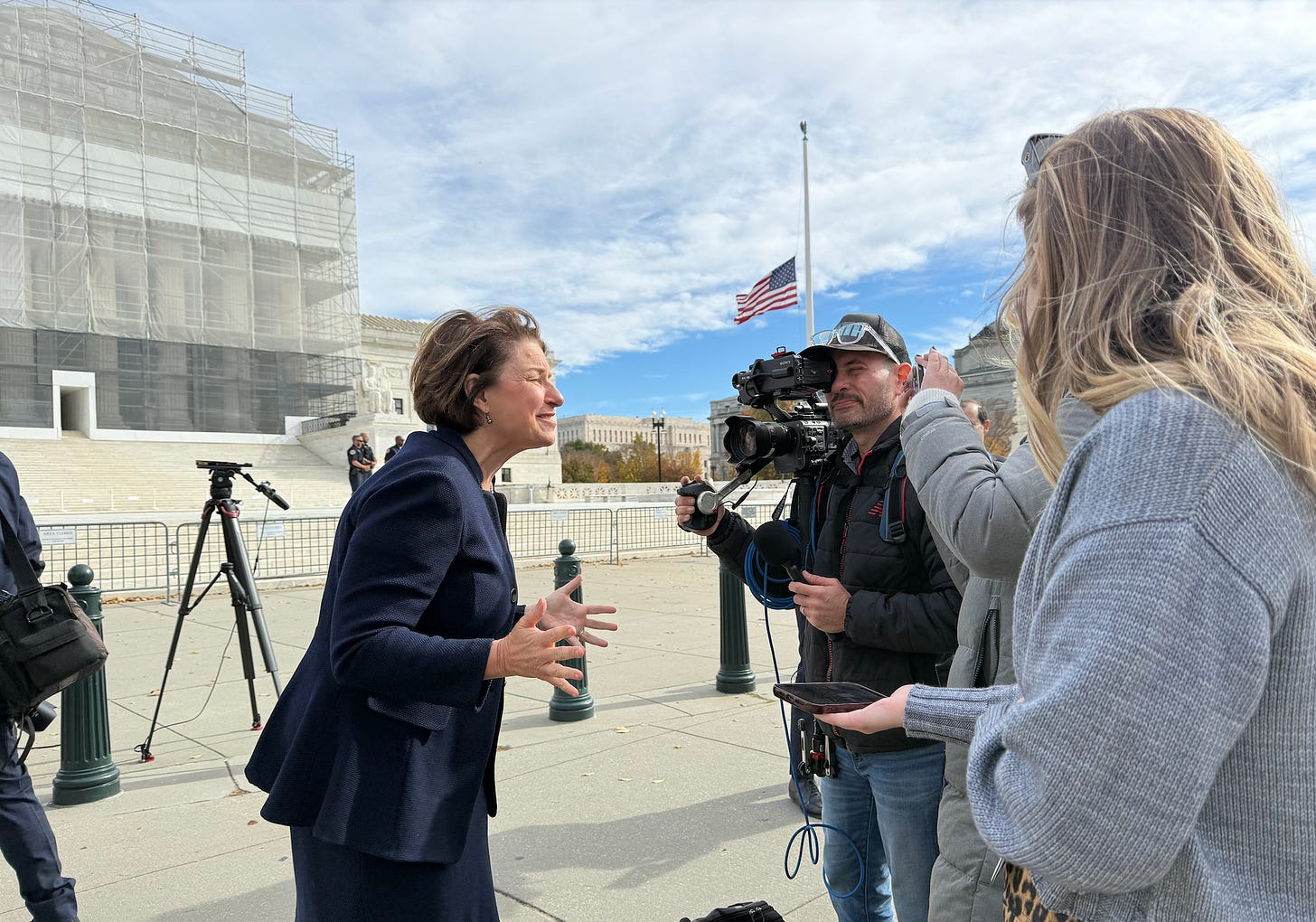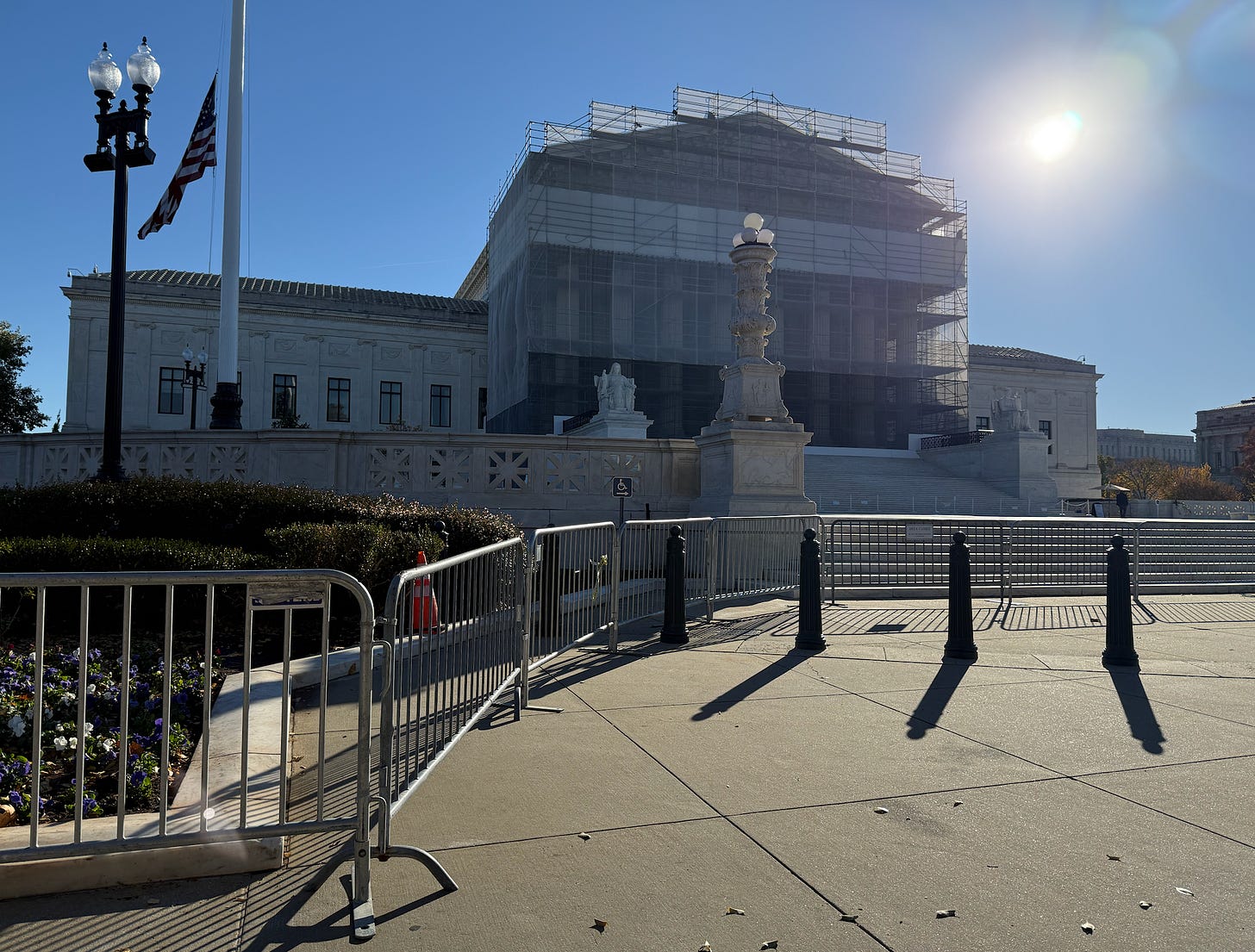Trump's tariffs face a skeptical SCOTUS as Gorsuch warns of a "one-way ratchet" in presidential powers
Kavanaugh stood out in defense of the administration, but even his questions started lagging as the day wore on.
As the U.S. Supreme Court considered the legality and, if necessary, constitutionality of President Donald Trump’s mass-imposition of tariffs, the lopsided nature of the arguments were most clearly seen in the halfhearted way Justice Sam Alito asked his questions.
Putting it plainly, his heart just wasn’t in it.
The questions from Alito were almost rote. At one point in his questioning of Neal Katyal, representing companies challenging the tariffs, Alito asked whether the tariffs could have been issued under a different law than the International Emergency Economic Powers Act (IEEPA), the law the Trump administration actually relied upon to justify the challenged tariffs.
Katyal was not exactly confused by the question, but it did prompt an almost quizzical “at that point, we’d have that case” response.
It was a moment that seemed to signify just how badly the arguments had gone for Solicitor General John Sauer, who went first during Wednesday’s nearly three hours of arguments. Before joining the Justice Department earlier this year, Sauer was one of Trump’s private lawyers, representing him before the Supreme Court in the immunity case, among other matters.
With Treasury Secretary Scott Bessent, Commerce Secretary Howard Lutnick, and U.S. Trade Representative Jamieson Greer sitting in the front row of the public seating section representing the (white, male) face of the Trump administration, Sauer faced an extremely skeptical bench.
Of the Republican appointees, Chief Justice John Roberts and Justices Neil Gorsuch and Amy Coney Barrett all asked openly skeptical questions of the Trump administration’s argument that the IEEPA — which does not mention tariffs — silently authorized a massive grant of authority to the president outside of and unlike any of the laws that explicitly grant the president tariff authority. For his part, Justice Clarence Thomas asked a handful of relatively muted questions — and one follow-on question to Alito’s questioning that was succinctly addressed.
In an argument in which Sauer constantly referred back to the president’s foreign affairs authority for the tariffs, he faced strong pushback from Roberts.
“Yes, of course, tariffs deal with foreign powers, but the vehicle is imposition of taxes on Americans, and that has always been the core power of Congress,” Roberts told Sauer bluntly toward the beginning of the morning, noting that seemed to him “to kind of at least neutralize” any claimed executive power.
Gorsuch, meanwhile, warned of how the power the administration was seeking would be a “one-way ratchet” because no executive would be likely to give up the extensive tariff-imposing power the Trump administration is claiming, meaning a super-majority in Congress sufficient to override a veto would likely be necessary to ever alter a ruling in Trump’s favor here. (Of course, this thinking would have been helpful at several other points in the recent past, but, here we are.)
All three Democratic appointees — Justices Sonia Sotomayor, Elena Kagan, and Ketanji Brown Jackson — asked clearly skeptical questions as well.
Toward the end of the arguments, Sotomayor revisited Roberts’s opening salvo.
“[T]he Constitution is structured so that if I’m going to be asked to pay for something as a citizen, that it’s through a bill that is generated through Congress and the President has the power to veto it or not,” she said to Oregon Solicitor General Benjamin Gutman, who was representing the dozen states that sued over the tariffs. “But I’m not going to be taxed unless both houses, the executive and the legislature, have made that choice, correct?”
Gutman, seeing the friendly question for what it was, replied, “That’s exactly right.“
Only Justice Brett Kavanaugh voiced strong support for any of the administration’s arguments in the case, and, as the arguments wore on from Sauer to Katyal to Gutman’s time at the podium, even Kavanaugh started to appear to be lagging.
The main question coming out of arguments was what reasoning will control the court’s likely decision blocking the administration’s use of IEEPA to justify Trump’s tariffs.
How could the court resolve the case?
Gorsuch was pushing the court heavily toward a ruling that would expand or at least solidify the pedigree of the major questions doctrine — used by the court to block Biden administration efforts, including the student loan forgiveness plan. Doing so here would be a chance for the court — i.e., Roberts or Gorsuch — to make the case that it really is a neutral policy that applies to all presidents, while at the same time bringing the Democratic appointees along and into a majority opinion based on the doctrine. (There were also a handful of questions about the related nondelegation doctrine question of whether, as a constitutional matter, Congress could give the president the power the administration is arguing it has.)
It could be for that reason that Kagan and others were pressing the statutory, “plain text“ argument against the administration. If the court were to go that way, there would be no need to get into the major questions or nondelegation doctrines.
The relevant portion of the law pointed to by Sauer was — pulling out the portions that the Trump administration argues authorize the tariffs — as follows:
“[T]he President may … by means of instructions, licenses, or otherwise … regulate … importation … of … any property in which any foreign country or a national thereof has any interest by any person, or with respect to any property, subject to the jurisdiction of the United States.”
Looking at the full law, however, Kagan focused on the word “regulate” and where it is found in the law.
* * *
“[I]t has a lot of verbs. It has a lot of actions that can be taken under this statute,” Kagan told him of that section. “It just doesn’t have the one you want.“
The “verbs” setting out what the president can do are: “investigate, block during the pendency of an investigation, regulate, direct and compel, nullify, void, prevent or prohibit.“ How, in that context, Kagan asked, would “regulate” allow tariffs?
Sotomayor picked up on that, noting that the actual law poses another problem for Sauer’s argument. Although Sauer has focused the case on “regulate … importation,” Sotomayor explained that the law says the president can “regulate … importation or exportation,” and, given that, asked why that would suggest tariffs since exportation would not ever involve tariffs.
For her part, Barrett repeatedly asked Sauer for “any other place in the Code or any other time in history where that phrase together, ‘regulate ... importation,’ has been used to confer tariff-imposing authority?“
Aside from the statute that preceded IEEPA, Sauer had nothing, talking around her question and prompting Sotomayor to interject at one point, “Could you just answer the Justice’s question?”

What happened to the Trump administration’s arguments?
At every turn, arguments and hypotheticals from the administration or aimed at buttressing the administration’s arguments had rock-solid responses from Katyal, Gutman, and the justices themselves.
Jackson — challenging the “premise” of Sauer’s argument that Congress would give the president “broad leeway” in this area — provided a sharp statement of where the court found itself on Wednesday morning.
“[M]y point is that Congress enacted this legislation with the intent of preventing the President from having unlimited powers in this area,” she said, “and you’re asking us to now interpret that statute consistent with an understanding that Congress wanted to allow the President to do pretty much whatever he wanted in this area.”
On the major questions front, Roberts put it just as bluntly to Sauer:
You have a claimed source in IEEPA that had never before been used to justify tariffs. No one has argued that it does until this particular case. Congress uses tariffs in other provisions but not here. And yet — and correct me on this if I’m not right about it — the justification is being used for a power to impose tariffs on any product from any country in any amount for any length of time.
That seems like — I’m not suggesting it’s not there, but it does seem like that’s major authority, and the basis for the claim seems to be a misfit.
On the argument made by Sauer and Alito that IEEPA is a law addressing emergencies and, as such, should be read broadly, Katyal retorted, “I think it cuts the other way.“ Referencing Justice Jackson’s famed 1952 opinion setting forth the modern understanding of presidential powers (and the limits on it), he continued, “[A]s Justice Jackson said, when you’re in an emergency situation, the statutes actually have to speak with more precision. The public needs to know because emergencies beget emergencies.“1
When Barrett raised another area of questioning related to the text of the law — about the understanding and scope of “licenses,” as used in the law — and whether that would be a way of accomplishing Trump’s goals here, Katyal was quick to rule that out.
“IEEPA and [the predecessor statute] authorize licenses, not license fees,” he told her. “And no President has ever charged, to my knowledge, fees under those two statutes for the licenses.”
After Alito had tried to make the case for why ruling out tariffs under IEEPA could be troubling, as a policy matter, Thomas posed a follow-on hypothetical about China holding “a U.S. citizen hostage.” He then asked Katyal, “[C]ould the President, short of embargoing or setting quotas, say the most effective way to gain leverage is to impose a tariff for the purpose of leveraging his position to recover our hostage?”
Katyal replied simply: “No, Your Honor.”
On the argument that, under IEEPA, tariffs would be a “lesser included” power to actually shutting down trade altogether, both Katyal and Gutman repeatedly explained that revenue-raising provisions are treated differently. Gutman, however, put the matter to rest when Kavanaugh asked him why a “rational Congress” would allow the president to shut down trade but not impose tariffs — citing DOJ’s brief for the claim that that’s “an odd donut hole in the statute.”
In response, Gutman told him the distinction “absolutely” makes sense.
“[I]t’s not a donut hole; it’s a different kind of pastry,“ he said.
The court is expected to issue decisions from this term’s cases by late June 2026, and, given the importance of this case, it generally would be expected to take time to get a decision. But, because rejection of the the tariffs could lead to refunds needing to be issued for tariffs paid during this period, expect a quicker turnaround if the court votes, as appeared likely Wednesday, to reject the administration’s arguments.
In part, Jackson wrote of the founders, “They knew what emergencies were, knew the pressures they engender for authoritative action, knew, too, how they afford a ready pretext for usurpation. We may also suspect that they suspected that emergency powers would tend to kindle emergencies.“






What does Trump have on Kavanaugh?
“Half-hearted” indeed. SCOTUS is faced with substance - the constitutionality of the tariffs - as opposed to easily disposed-of procedural rules … and something it can’t decide without explanation— no wonder it’s hesitant.